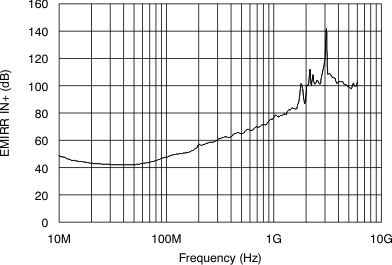SBOS860 April 2017 OPA188-Q1 , OPA2188-Q1
PRODUCTION DATA.
- 1 Features
- 2 Applications
- 3 Description
- 4 Revision History
- 5 Device Comparison Table
- 6 Pin Configuration and Functions
- 7 Specifications
- 8 Detailed Description
- 9 Application and Implementation
- 10Power Supply Recommendations
- 11Layout
- 12Device and Documentation Support
- 13Mechanical, Packaging, and Orderable Information
Package Options
Mechanical Data (Package|Pins)
- DGK|8
Thermal pad, mechanical data (Package|Pins)
- DGK|8
Orderable Information
7 Specifications
7.1 Absolute Maximum Ratings
over operating free-air temperature range (unless otherwise noted)(1)| MIN | MAX | UNIT | |||
|---|---|---|---|---|---|
| Voltage | Supply | Split-supply | ±20 | V | |
| Single-supply | 40 | ||||
| Signal input pins(2) | (V–) – 0.5 | (V+) + 0.5 | |||
| Differential | ±0.7 | ||||
| Current | Signal input pins(2) | ±10 | mA | ||
| Output short-circuit(3) | Continuous | ||||
| Temperature | OPA188-Q1, TJ | 150 | °C | ||
| OPA2188-Q1, TJ | 125 | °C | |||
| Storage, Tstg | –65 | 150 | °C | ||
(1) Stresses beyond those listed under Absolute Maximum Ratings may cause permanent damage to the device. These are stress ratings only, which do not imply functional operation of the device at these or any other conditions beyond those indicated under Recommended Operating Conditions. Exposure to absolute-maximum-rated conditions for extended periods may affect device reliability.
(2) Input terminals are diode-clamped to the power-supply rails. Input signals that can swing more than 0.5 V beyond the supply rails should be current-limited to 10 mA or less.
(3) Short-circuit to ground, V– or V+.
7.2 ESD Ratings
| VALUE | UNIT | |||
|---|---|---|---|---|
| V(ESD) | Electrostatic discharge | Human-body model (HBM), per AEC Q100-002(1) | ±1500 | V |
| Charged-device model (CDM), per AEC Q100-011 | ±750 | |||
(1) AEC Q100-002 indicates that HBM stressing shall be in accordance with the ANSI/ESDA/JEDEC JS-001 specification.
7.3 Recommended Operating Conditions
over operating free-air temperature range (unless otherwise noted) RL = 10 kΩ connected to VS / 2 (2), and VCM = VOUT = VS / 2(2)| MIN | NOM | MAX | UNIT | |||
|---|---|---|---|---|---|---|
| VS | Operating voltage range | Split–supply | ±2 | ±18 | V | |
| Single–supply | 4 | 36 | ||||
| TA | OPA188-Q1 Temperature Grade 1: Specified temperature range | –40 | 125 | °C | ||
| OPA2188-Q1 Temperature Grade 2: Specified temperature range | –40 | 105 | ||||
7.4 Thermal Information
| THERMAL METRIC(1) | OPA188-Q1 | OPA2188-Q1 | UNIT | |
|---|---|---|---|---|
| DGK (VSSOP) | DGK (VSSOP) | |||
| 8 PINS | 8 PINS | |||
| RθJA | Junction-to-ambient thermal resistance | 171.7 | 163.2 | °C/W |
| RθJC(top) | Junction-to-case (top) thermal resistance | 62.7 | 57.4 | °C/W |
| RθJB | Junction-to-board thermal resistance | 93.0 | 83.4 | °C/W |
| ψJT | Junction-to-top characterization parameter | 9.0 | 6.6 | °C/W |
| ψJB | Junction-to-board characterization parameter | 91.4 | 82.0 | °C/W |
| RθJC(bot) | Junction-to-case (bottom) thermal resistance | N/A | N/A | °C/W |
(1) For more information about traditional and new thermal metrics, see the Semiconductor and IC Package Thermal Metrics application report.
7.5 Electrical Characteristics: High-Voltage Operation
at TA = 25°C, VS = ±4 V to ±18 V (VS = 8 V to 36 V), RL = 10 kΩ connected to VS / 2 (2), and VCM = VOUT = VS / 2(2)(unless otherwise noted)
| PARAMETER | CONDITIONS | MIN | TYP | MAX | UNIT | ||
|---|---|---|---|---|---|---|---|
| OFFSET VOLTAGE | |||||||
| VOS | Input offset voltage | ±6 | ±25 | μV | |||
| dVIO/dT | Input offset voltage drift | OPA188-Q1 TA = –40°C to 125°C |
±0.03 | ±0.085 | μV/°C | ||
| OPA2188-Q1 TA = –40°C to 105°C |
±0.03 | ±0.085 | μV/°C | ||||
| PSRR | Power-supply rejection ratio | OPA188-Q1 VS = 4 V to 36 V TA = –40°C to 125°C |
±0.075 | ±0.3 | μV/V | ||
| OPA2188-Q1 VS = 4 V to 36 V TA = –40°C to 105°C |
±0.075 | ±0.3 | μV/V | ||||
| Long-term stability(1) | 4 | μV | |||||
| INPUT BIAS CURRENT | |||||||
| IB | Input bias current | VCM = VS / 2 | ±160 | ±1400 | pA | ||
| OPA188-Q1 TA = –40°C to 125°C |
±18 | nA | |||||
| OPA2188-Q1 TA = –40°C to 105°C |
±18 | nA | |||||
| IOS | Input offset current | VCM = VS / 2 | ±320 | ±2800 | pA | ||
| OPA188-Q1 TA = –40°C to 125°C |
±6 | nA | |||||
| OPA2188-Q1 TA = –40°C to 105°C |
±6 | nA | |||||
| NOISE | |||||||
| en | Input voltage noise | f = 0.1 Hz to 10 Hz | 250 | nVPP | |||
| f = 0.1 Hz to 10 Hz | 40 | nVrms | |||||
| Input voltage noise density | f = 1 kHz | 8.8 | nV/√Hz | ||||
| in | Input current noise density | f = 1 kHz | 7 | fA/√Hz | |||
| INPUT VOLTAGE RANGE | |||||||
| VCM | Common-mode voltage range | OPA188-Q1 TA = –40°C to 125°C |
V– | (V+) – 1.5 | V | ||
| OPA2188-Q1 TA = –40°C to 105°C |
V– | (V+) – 1.5 | V | ||||
| CMRR | Common-mode rejection ratio | (V–) < VCM < (V+) – 1.5 V | 120 | 134 | dB | ||
| (V–) + 0.5 V < VCM < (V+) – 1.5 V VS = ±18 V |
130 | 146 | dB | ||||
| OPA188-Q1 (V–) + 0.5 V < VCM < (V+) – 1.5 V VS = ±18 V, TA = –40°C to 125°C |
120 | 126 | dB | ||||
| OPA2188-Q1 (V–) + 0.5 V < VCM < (V+) – 1.5 V VS = ±18 V, TA = –40°C to 105°C |
120 | 126 | dB | ||||
| INPUT IMPEDANCE | |||||||
| ZID | Differential | 100 || 6 | MΩ || pF | ||||
| ZIC | Common-mode | 6 || 9.5 | 1012 Ω || pF | ||||
| OPEN-LOOP GAIN | |||||||
| AOL | Open-loop voltage gain | (V–) + 0.5 V < VO < (V+) – 0.5 V | 130 | 136 | dB | ||
| OPA188-Q1 (V–) + 0.5 V < VO < (V+) – 0.5 V TA = –40°C to 125°C |
120 | 126 | dB | ||||
| OPA2188-Q1 (V–) + 0.5 V < VO < (V+) – 0.5 V TA = –40°C to 105°C |
120 | 126 | dB | ||||
| FREQUENCY RESPONSE | |||||||
| GBW | Gain-bandwidth product | 2 | MHz | ||||
| SR | Slew rate | G = 1 | 0.8 | V/μs | |||
| tS | Settling time | 0.1% | VS = ±18 V, G = 1, 10-V step | 20 | μs | ||
| 0.01% | VS = ±18 V, G = 1, 10-V step | 27 | μs | ||||
| tOR | Overload recovery time | VIN × G = VS | 1 | μs | |||
| THD+N | Total harmonic distortion + noise | 1 kHz, G = 1, VOUT = 1 VRMS | 0.0001% | ||||
| OUTPUT | |||||||
| Voltage output swing from rail | No load | 6 | 15 | mV | |||
| RL = 10 kΩ | 220 | 250 | mV | ||||
| OPA188-Q1 RL = 10 kΩ, TA = –40°C to 125°C |
310 | 350 | mV | ||||
| OPA2188-Q1 RL = 10 kΩ, TA = –40°C to 105°C |
310 | 350 | mV | ||||
| ISC | Short-circuit current | Sinking | –18 | mA | |||
| Sourcing | 16 | mA | |||||
| RO | Open-loop output resistance | f = 1 MHz, IO = 0 mA | 120 | Ω | |||
| CLOAD | Capacitive load drive | 1 | nF | ||||
| POWER SUPPLY | |||||||
| IQ | Quiescent current (per amplifier) | VS = ±4 V to VS = ±18 V | 450 | 510 | μA | ||
| OPA188-Q1 IO = 0 mA TA = –40°C to 125°C |
600 | μA | |||||
| OPA2188-Q1 IO = 0 mA TA = –40°C to 105°C |
600 | μA | |||||
(1) 1000-hour life test at 125°C demonstrated randomly distributed variation in the range of measurement limits at approximately 4 μV.
(2) VS / 2 = midsupply.
7.6 Electrical Characteristics: Low-Voltage Operation
at TA = 25°C, VS = ±2 V to < ±4 V (VS = 4 V to < 8 V), RL = 10 kΩ connected to VS / 2(2), and VCM = VOUT = VS / 2(2)(unless otherwise noted)
| PARAMETER | CONDITIONS | MIN | TYP | MAX | UNIT | ||
|---|---|---|---|---|---|---|---|
| OFFSET VOLTAGE | |||||||
| VOS | Input offset voltage | ±6 | ±25 | μV | |||
| dVIO/dT | Input offset voltage drift | OPA188-Q1 TA = –40°C to 125°C |
±0.03 | ±0.085 | μV/°C | ||
| OPA2188-Q1 TA = –40°C to 105°C |
±0.03 | ±0.085 | μV/°C | ||||
| PSRR | Power-supply rejection ratio | OPA188-Q1 VS = 4 V to 36 V TA = –40°C to 125°C |
0.075 | 0.3 | μV/V | ||
| OPA2188-Q1 VS = 4 V to 36 V TA = –40°C to 105°C |
0.075 | 0.3 | μV/V | ||||
| Long-term stability(1) | 4 | μV | |||||
| INPUT BIAS CURRENT | |||||||
| IB | Input bias current | ±160 | ±1400 | pA | |||
| OPA188-Q1 TA = –40°C to 125°C |
±18 | nA | |||||
| OPA2188-Q1 TA = –40°C to 105°C |
±18 | nA | |||||
| IOS | Input offset current | ±320 | ±2800 | pA | |||
| OPA188-Q1 TA = –40°C to 125°C |
±6 | nA | |||||
| OPA2188-Q1 TA = –40°C to 105°C |
±6 | nA | |||||
| NOISE | |||||||
| en | Input voltage noise | f = 0.1 Hz to 10 Hz | 250 | nVPP | |||
| f = 0.1 Hz to 10 Hz | 40 | nVrms | |||||
| Input voltage noise density | f = 1 kHz | 8.8 | nV/√Hz | ||||
| in | Input current noise density | f = 1 kHz | 7 | fA/√Hz | |||
| INPUT VOLTAGE RANGE | |||||||
| VCM | Common-mode voltage range | OPA188-Q1 TA = –40°C to 125°C |
V– | (V+) – 1.5 | V | ||
| OPA2188-Q1 TA = –40°C to 105°C |
V– | (V+) – 1.5 | V | ||||
| CMRR | Common-mode rejection ratio | (V–) < VCM < (V+) – 1.5 V | 106 | 114 | dB | ||
| (V–) + 0.5 V < VCM < (V+) – 1.5 V VS = ±2 V |
114 | 120 | dB | ||||
| OPA188-Q1 (V–) + 0.5 V < VCM < (V+) – 1.5 V VS = ±2 V, TA = –40°C to 125°C |
110 | 120 | dB | ||||
| OPA2188-Q1 (V–) + 0.5 V < VCM < (V+) – 1.5 V VS = ±2 V, TA = –40°C to 105°C |
110 | 120 | dB | ||||
| INPUT IMPEDANCE | |||||||
| ZID | Differential | 100 || 6 | MΩ || pF | ||||
| ZIC | Common-mode | 6 || 9.5 | 1012 Ω || pF | ||||
| OPEN-LOOP GAIN | |||||||
| AOL | Open-loop voltage gain | (V–) + 0.5 V < VO < (V+) – 0.5 V RL = 5 kΩ |
110 | 120 | dB | ||
| (V–) + 0.5 V < VO < (V+) – 0.5 V | 120 | 130 | dB | ||||
| OPA188-Q1 (V–) + 0.5 V < VO < (V+) – 0.5 V TA = –40°C to 125°C |
110 | 120 | dB | ||||
| OPA2188-Q1 (V–) + 0.5 V < VO < (V+) – 0.5 V TA = –40°C to 105°C |
110 | 120 | dB | ||||
| FREQUENCY RESPONSE | |||||||
| GBW | Gain-bandwidth product | 2 | MHz | ||||
| SR | Slew rate | G = 1 | 0.8 | V/μs | |||
| tOR | Overload recovery time | VIN × G = VS | 1 | μs | |||
| THD+N | Total harmonic distortion + noise | 1 kHz, G = 1, VOUT = 1 VRMS | 0.0001% | ||||
| OUTPUT | |||||||
| Voltage output swing from rail | No load | 6 | 15 | mV | |||
| RL = 10 kΩ | 220 | 250 | mV | ||||
| OPA188-Q1 RL = 10 kΩ, TA = –40°C to 125°C |
310 | 350 | mV | ||||
| OPA2188-Q1 RL = 10 kΩ, TA = –40°C to 105°C |
310 | 350 | mV | ||||
| ISC | Short-circuit current | Sinking | –18 | mA | |||
| Sourcing | 16 | mA | |||||
| RO | Open-loop output resistance | f = 1 MHz, IO = 0 mA | 120 | Ω | |||
| CLOAD | Capacitive load drive | 1 | nF | ||||
| POWER SUPPLY | |||||||
| IQ | Quiescent current (per amplifier) | VS = ±2 V to VS = ±4 V | 425 | 485 | μA | ||
| OPA188-Q1 IO = 0 mA TA = –40°C to 125°C |
575 | μA | |||||
| OPA2188-Q1 IO = 0 mA TA = –40°C to 105°C |
575 | μA | |||||
(1) 1000-hour life test at 125°C demonstrated randomly distributed variation in the range of measurement limits at approximately 4 μV.
(2) VS / 2 = midsupply.
7.7 Typical Characteristics: Table of Graphs
7.7.1 Table of Graphs
Table 1. Typical Characteristic Graphs
| DESCRIPTION | FIGURE |
|---|---|
| Offset Voltage Production Distribution | Figure 1 |
| Offset Voltage Drift Distribution | Figure 2 |
| Offset Voltage vs Temperature | Figure 3 |
| Offset Voltage vs Common-Mode Voltage | Figure 4, Figure 5 |
| Offset Voltage vs Power Supply | Figure 6 |
| Open-Loop Gain and Phase vs Frequency | Figure 7 |
| Closed-Loop Gain vs Frequency | Figure 8 |
| IB and IOS vs Common-Mode Voltage | Figure 9 |
| Input Bias Current vs Temperature | Figure 10 |
| Output Voltage Swing vs Output Current (Maximum Supply) | Figure 11 |
| CMRR and PSRR vs Frequency (Referred-to-Input) | Figure 12 |
| CMRR vs Temperature | Figure 13, Figure 14 |
| PSRR vs Temperature | Figure 15 |
| 0.1-Hz to 10-Hz Noise | Figure 16 |
| Input Voltage Noise Spectral Density vs Frequency | Figure 17 |
| THD+N Ratio vs Frequency | Figure 18 |
| THD+N vs Output Amplitude | Figure 19 |
| Quiescent Current vs Supply Voltage | Figure 20 |
| Quiescent Current vs Temperature | Figure 21 |
| Open-Loop Gain vs Temperature | Figure 22 |
| Open-Loop Output Impedance vs Frequency | Figure 23 |
| Small-Signal Overshoot vs Capacitive Load (100-mV Output Step) | Figure 24, Figure 25 |
| No Phase Reversal | Figure 26 |
| Positive Overload Recovery | Figure 27 |
| Negative Overload Recovery | Figure 28 |
| Small-Signal Step Response (100 mV) | Figure 29, Figure 30 |
| Large-Signal Step Response | Figure 31, Figure 32 |
| Large-Signal Settling Time (10-V Positive Step) | Figure 33 |
| Large-Signal Settling Time (10-V Negative Step) | Figure 34 |
| Short-Circuit Current vs Temperature | |
| Maximum Output Voltage vs Frequency | Figure 35 |
| EMIRR IN+ vs Frequency | Figure 36 |
7.8 Typical Characteristics
at VS = ±18 V, VCM = VS / 2, RLOAD = 10 kΩ connected to VS / 2, and CL = 100 pF (unless otherwise noted)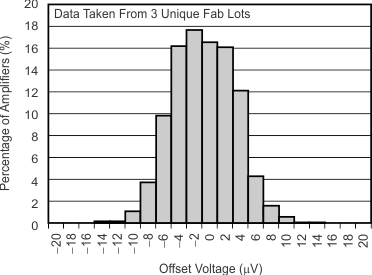
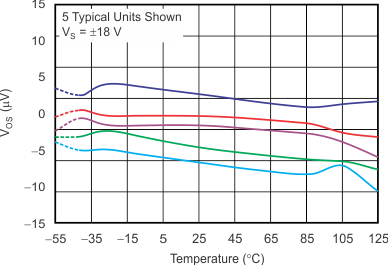
| OPA188-Q1 is specified from TA = –40°C to +125°C | ||
| OPA2188-Q1 is specified from TA = –40°C to +105°C |
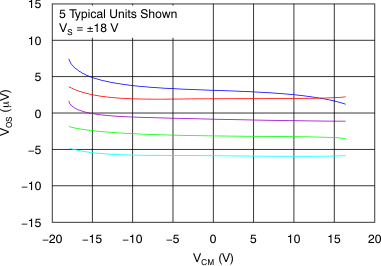
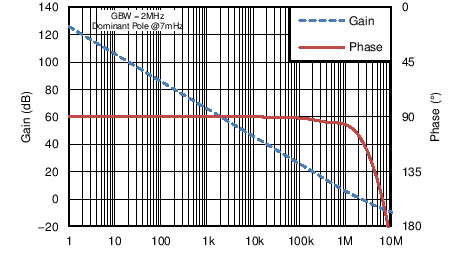
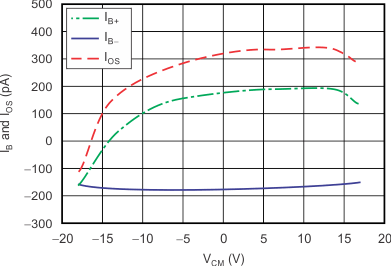
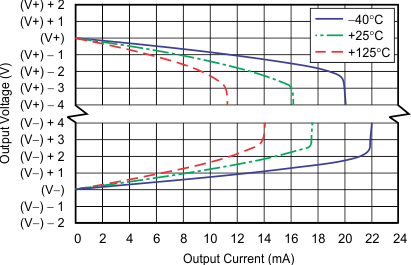
| OPA188-Q1 is specified from TA = –40°C to +125°C | ||
| OPA2188-Q1 is specified from TA = –40°C to +105°C |
Output Current (Maximum Supply)
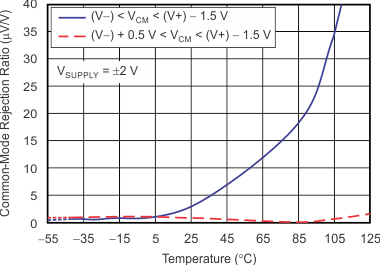
| OPA188-Q1 is specified from TA = –40°C to +125°C | ||
| OPA2188-Q1 is specified from TA = –40°C to +105°C |
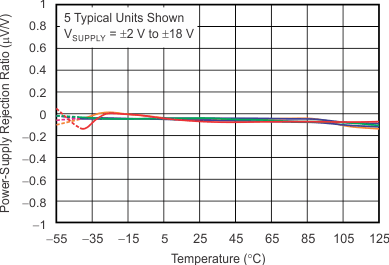
| OPA188-Q1 is specified from TA = –40°C to +125°C | ||
| OPA2188-Q1 is specified from TA = –40°C to +105°C |
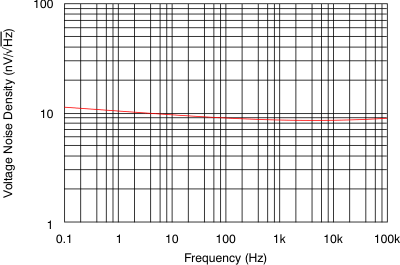
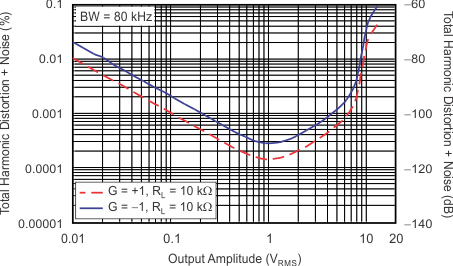
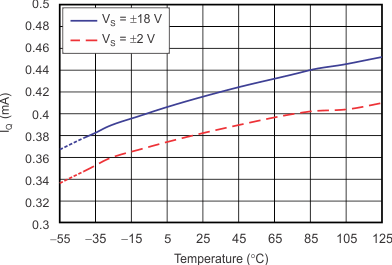
| OPA188-Q1 is specified from TA = –40°C to +125°C | ||
| OPA2188-Q1 is specified from TA = –40°C to +105°C |
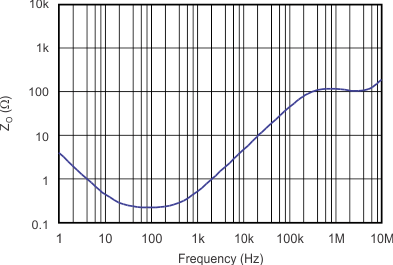
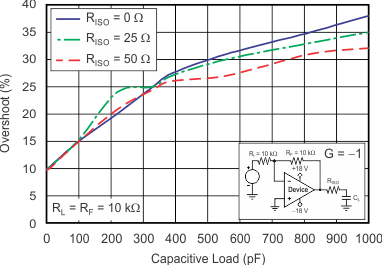
Capacitive Load (100-mV Output Step)
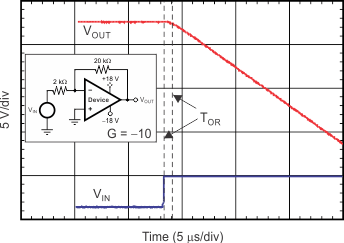
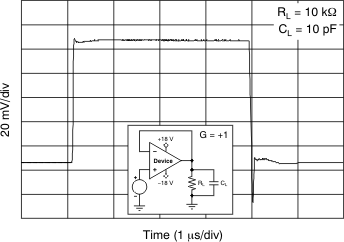
(100 mV)
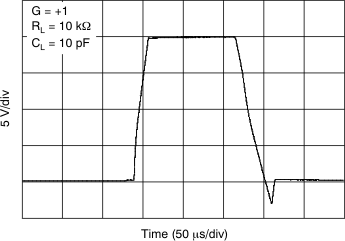
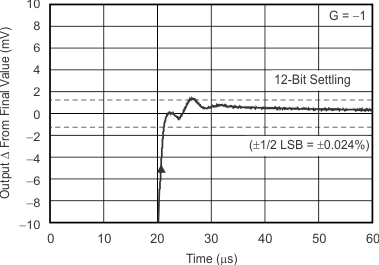
(10-V Positive Step)
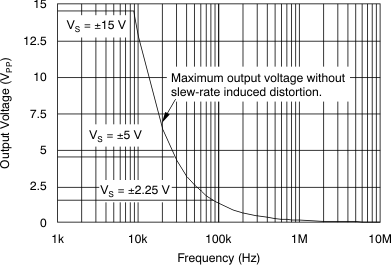
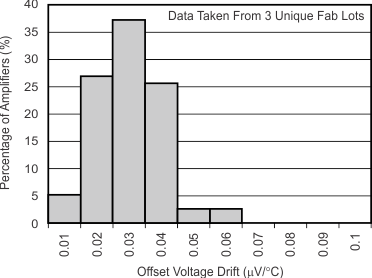
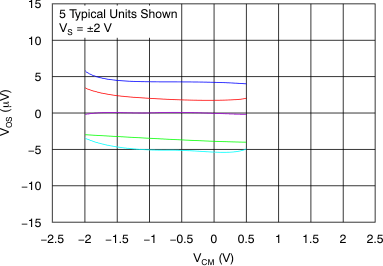
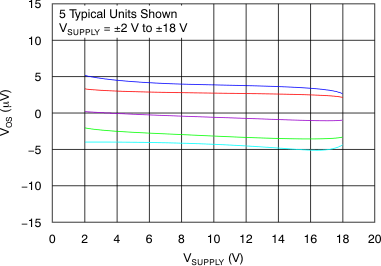
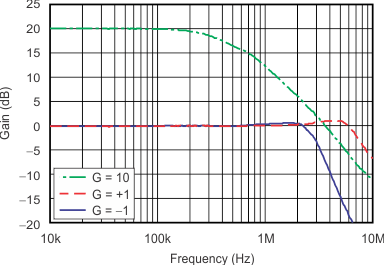
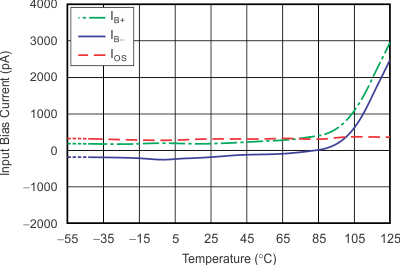
| OPA188-Q1 is specified from TA = –40°C to +125°C | ||
| OPA2188-Q1 is specified from TA = –40°C to +105°C |
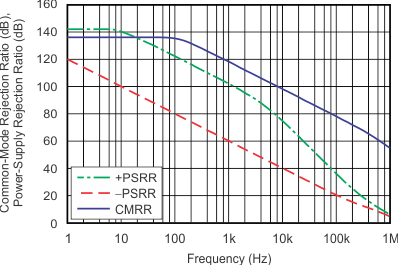
(Referred-to-Input)
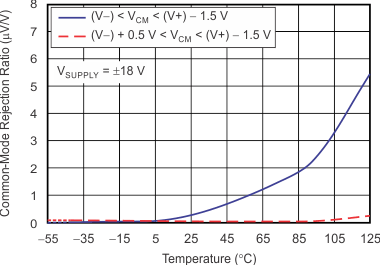
| OPA188-Q1 is specified from TA = –40°C to +125°C | ||
| OPA2188-Q1 is specified from TA =–40°C to +105°C |
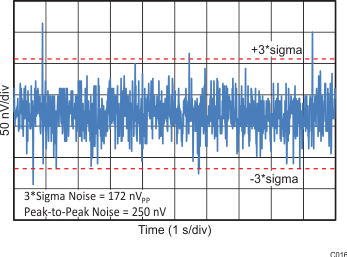
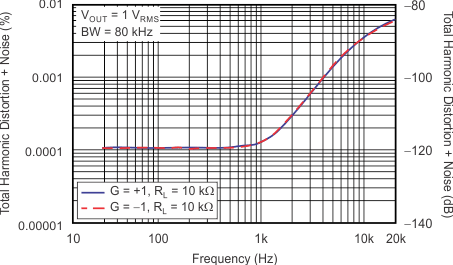
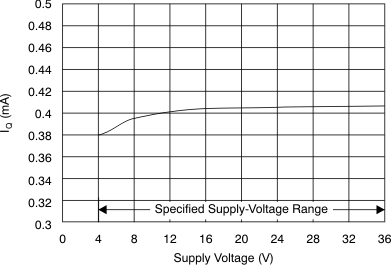
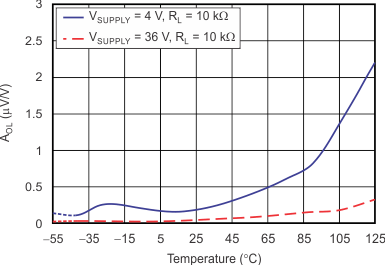
| OPA188-Q1 is specified from TA = –40°C to +125°C | ||
| OPA2188-Q1 is specified from TA = –40°C to +105°C |
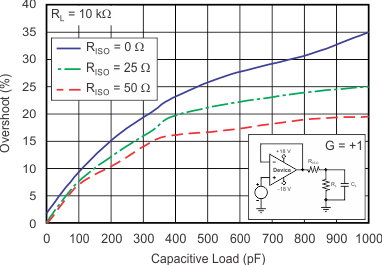
Capacitive Load (100-mV Output Step)
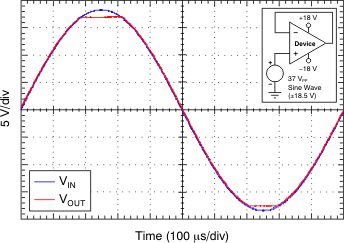
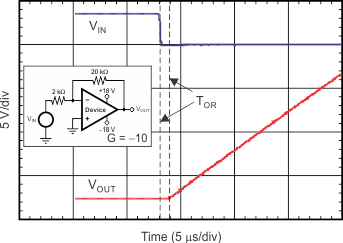
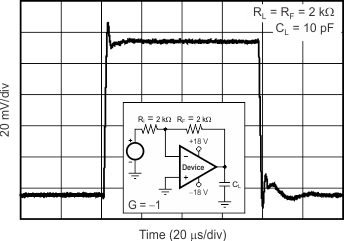
(100 mV)
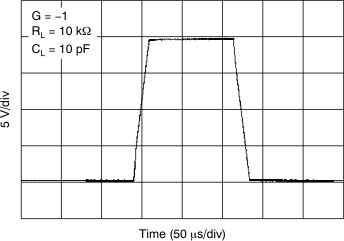
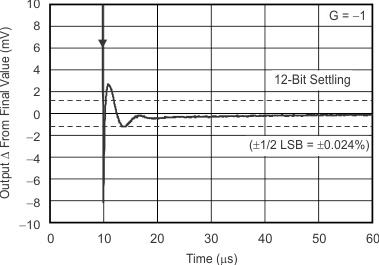
(10-V Negative Step)
